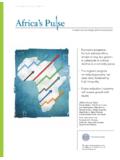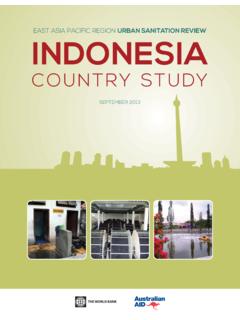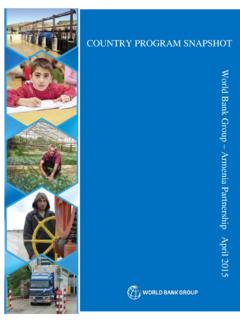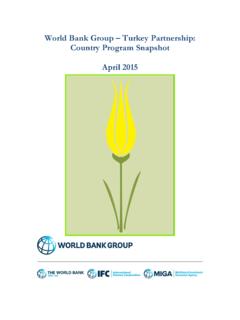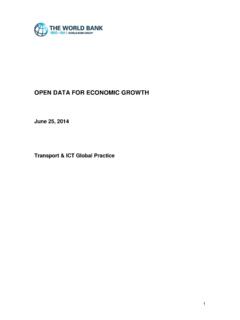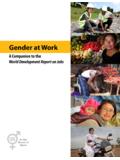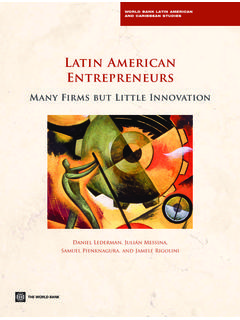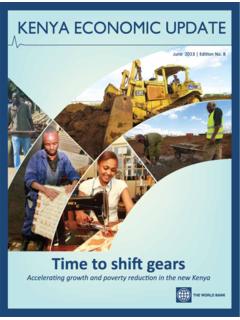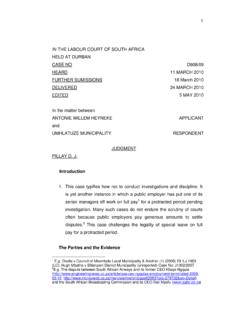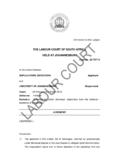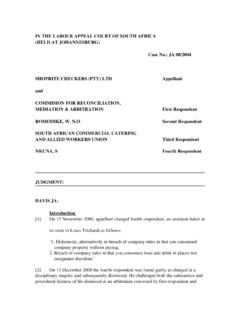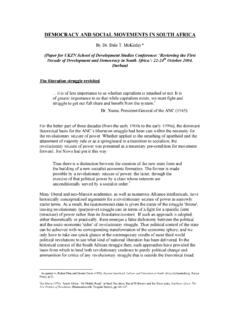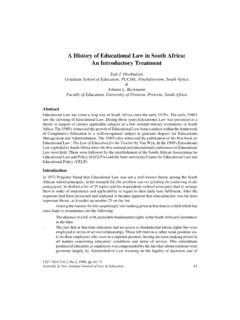Transcription of An analysis of issues shaping Africa’s economic future
1 APRIL 2013 | VOLUME 7An analysis of issues shaping africa s economic futureu Sub-Saharan African countries maintain growth momentum, as well as progress toward the MDGsu Growth has reduced poverty, but not by enoughu Better governance of mineral revenues, high agricultural prices, the demographic dividend and rapid urbanization represent opportunities for making growth more poverty reducingAFRICA S PULSE TEAM:Punam Chuhan-Pole (Team Leader)Luc Christiaensen, Manka Angwafo, Mapi Buitano, Allen Dennis, Vijdan Korman, Aly Sanoh and Xiao YeWith contributions from Shanta Devarajan, Jos Verbeek and Eugenia MoranThis document was produced bythe Office of the Chief Economistfor the africa regionAFRICA S PULSE>2A. RECENT DEVELOPMENTS IN THE GLOBAL ECONOMY More than four years after the financial crisis hit, the global economic recovery remains tepid, weighed down by weak activity in high-income countries, particularly in the Euro Area.
2 The recession in the Euro Area likely continued through Q1 2013. Euro Area industrial production data in January point to a broad-based contraction in activity ( , 3m/3m saar), even if the pace of decline has slowed. Recent market sentiment indicators signal the persistence of weak economic activity in the region. Although financial markets response to the Cyprus crisis has thus far been muted, it is still too early to assess the real-side impacts, if any, of this crisis on the wider Euro Area. It is unlikely to be favorable for the fragile recovery that is underway in the currency union. Nonetheless, acceleration in developing-country import demand and, to a lesser extent, in US imports is helping to mitigate some of the weakness in the Euro has firmed up in the US and stabilized in Japan. Despite the drag coming from higher payroll taxes and the sequester, industrial production in the United States expanded at an annualized pace of percent during the three months ending February 2013, supported by a recovering housing market and an increase in payroll jobs.
3 The recent strengthening of economic indicators in the US import demand, durable goods order, business sentiment indicators signal that economic activity in Q1 2013 will pick up from the flat output observed in Q4 2012. In Japan, January industrial production data show that the 8-month contraction in activity came to an end in January ( 3m/3m saar). This suggests that monetary and fiscal stimulus measures are boosting current quarter growth. However, if supply-side conditions do not improve this uptick may come at the expense of growth towards the end of the year and into 2014. Summaryu The global economic recovery remains tepid, but it is expected to gradually strengthen going Sub-Saharan African countries continue to grow at a strong pace, spurred by domestic demand and still high commodity prices. economic prospects are tilted to the Good progress has been made on a few MDGs, even though the region lags in achieving the development More than a decade of strong growth has reduced poverty in Sub-Saharan africa , but high inequality and resource dependence have dampened the poverty-reducing effect of income growth.
4 U Several opportunities mineral wealth, elevated food prices, rapid urbanization and a demographic dividend hold the promise of accelerating the income growth of the poorest groups, but appropriate policies are required to unleash this I: Recent Trends and Prospects u Fiscal consolidation and weak consumer and business sentiment in high-income countries continue to weigh down global growth, which is projected to tick up to percent in 2013. u economic output in Sub-Saharan africa expanded at nearly twice the global rate. With some of the fastest growing economies in the world, African growth is expected to accelerate to over 5 percent in 2013-15. africa S PULSE>3 Led by China, the recovery in developing country activity remains strong. Industrial production in developing countries expanded at a robust percent annualized pace in January ( , 6m/6m saar), driven in part by a strong percent expansion in China; excluding China, industrial production for developing countries grew at percent in January.
5 With China being an important trading partner for many developing countries, the robust growth there and subsequent strong import demand ( , 3m/3m saar in January) is supporting the expansion in industrial production in other developing (and high-income) countries. Strengthening activity in the United States should also bode well for developing country exports. Baseline projections are for a modest acceleration of growth between 2013 and 2015. Overall, global GDP is projected to expand by percent in 2013 and gradually strengthen to about 3 and percent in 2014 and 2015. For high-income countries, fiscal consolidation, high unemployment and still weak consumer and business confidence will continue to weigh on activity in 2013, with growth coming in at percent. But growth should firm to about 2 and percent in 2014 and 2015, respectively. Improved financial conditions, a relaxation of monetary policy, and somewhat stronger high-income country growth should prompt a gradual acceleration of developing country growth to about percent this year, and to and percent in 2014 and 2015 respectively roughly in line with underlying potential.
6 But future growth is not guaranteed. So far, developing countries have weathered the great recession relatively well as developing country growth has declined by only 1 percentage point over the 2000-07 average. Regaining, or surpassing, those growth rates will require sustained progress in raising supply potential by maintaining macroeconomic sustainability, improving governance, and investing in infrastructure, health and RECENT DEVELOPMENTS IN SUB-SAHARAN AFRICAD espite the global economic slowdown in 2012, growth in Sub-Saharan africa remained robust supported by resilient domestic demand and still high commodity prices. In 2012, the region s growth was estimated at percent. Excluding South africa , the region s largest economy, the remaining economies grew at a robust percent higher than the developing country average of percent (Figure1). About a quarter of countries in the region grew at 7 percent or better, and several African countries are among the fastest growing in the world (Figure 2).
7 Medium-term growth prospects remain strong and should be supported by a pick-up in the global economy, high commodity prices, and investment in the productive capacity of the region s economies. Overall, the region is forecast to grow at more than 5 percent on average over the 2013-15 period: Growth in Sub-Saharan africa remains robust at percent (excluding South africa ) in 2012 African countries are among the fastest growing countries in the worldFIGURE 1: Real GDP growth and prospectsFIGURE 2: Fastest growing Sub-Saharan African countries in 20122001 2003 2005 2007 2009 2011 2013 2015 Developing (ex. China) Sub-Saharan africa Sub-Saharan africa (ex. South africa ) -1 1 3 5 7 (real GDP growth, % ch) 0369121518 IndiaGhanaZambiaMozambiqueChinaRwandaBur kina FasoEthiopiaLiberiaCote d'IvoireNigerSierra LeoneSource: Development Prospects : Development Prospects S PULSE>4percent in 2013, gradually strengthening to percent by 2015.
8 Increased investment flows are supporting the region s growth performance, with investment-to-GDP ratios increasing by an average of percentage points per annum over the past decade (Figure 3). In 2012, for instance, net private capital flows to the region increased by percent to a record $ billion, notwithstanding the percent decline in capital flows to developing countries. Foreign direct investment flows tend to dominate capital inflows to the region, thanks to a wealth of extractive resources, but also because other forms of capital flows such as portfolio and bank lending to the region are limited by less developed capital markets and a banking sector that is less integrated with global financial markets (South africa and Mauritius are exceptions). Foreign direct investment (FDI) to the region increased by percent in 2012 to $ billion, although for developing countries as an aggregate these flows fell by percent (Figure 4).
9 The resilience of FDI flows to the region in 2012 reflects, inter alia, still high commodity prices (even though prices softened during the year). In 2012, several mines were expanded or new ones constructed; prospecting yielded major gas discoveries along the east coast of africa ; new, commercially viable oil wells were drilled in West africa and East africa ; and a number of countries discovered new mineral deposits. While both foreign and domestic-originating private and public investments (mainly infrastructure-related) have increased, the investment-to-GDP ratio of about 22 percent in Sub-Saharan africa is the lowest among developing regions. The region s investment-to-GDP ratios are at levels observed in China in the early 1960 s and India in the early 1980 s both prior to their economic boom, suggesting increased scope for further expansion in productivity-enhancing investment in the the extractive industry sector dominates in terms of the value of overall FDI flows, investment in the services sector, notably among infrastructure-related projects in construction, transportation, electricity, telecommunication and water, has been expanding.
10 In addition, some of the larger economies with a growing middle-class such as Nigeria, South africa , Kenya and Ghana, are increasingly attracting investment flows to their rapidly expanding consumer sector: retail and consumer banking. The contribution of the service sector to economic growth is large in both resource-rich and resource-poor countries (Figure 14). africa is an attractive investment destination: The United Nations World Investment Report, 2012 reports that data on the profitability of United States FDI FDI income as a share of FDI stock shows a 20 percent return in africa in 2010, compared with 14 percent in Latin America and the Caribbean and 15 percent in investment is supporting economic growthFDI flows to Sub-Saharan africa held up in 2012, despite a weaker global economic environmentFIGURE 3: Investment and growth in Sub-Saharan africa , 1992-2011 FIGURE 4: Foreign direct investment flowsSource: Development Prospects.
